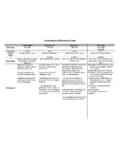Transcription of Using X-DNA for Genealogy - debbiewayne.com
1 2014, Debbie Parker Wayne, All rights reserved. Using X-DNA for Genealogy Debbie Parker Wayne, CG, CGLSM. This is one article of a series on Using DNA for genealogical research. There are several types of DNA tests offered for genealogical purposes. Researchers must understand that only like tests can be compared: Y-DNA to Y-DNA, mitochondrial DNA (mtDNA) to mtDNA, autosomal DNA (atDNA) to atDNA, and X-DNA to X-DNA . To use DNA to solve a problem, an understanding of DNA inheritance and the limits of the evidence is paramount. This article covers X-DNA and builds on the atDNA article in the last issue. Specialized X-DNA short tandem repeat (STR) tests are not covered in this article. Earlier articles have shown how to research our patrilineal line Using Y-DNA which is passed only from a father to his sons; our matrilineal line Using mtDNA which is passed only from a mother to all of her children, with only daughters passing it to the next generation; and all of our recent ancestral lines Using atDNA inherited from all of the ancestors on our pedigree chart.
2 X-DNA . follows a unique inheritance pattern that is different in males and females and includes only some of our ancestral lines. WHAT CAN YOU DO WITH X-DNA ? For most genealogical problems, X-DNA alone is not useful. It is used in correlation with other DNA evidence to support a theory. For example, atDNA might support a theory that two people are descended from a common ancestor while X-DNA provides evidence for the ancestral line that common ancestor is part of. X-DNA focuses research on the most likely ancestral lines on which you may be related to a person and excludes other lines as a possibility. Because of random recombination, the absence of an X-DNA match does not prove you are not related on a particular line, but the existence of an X-DNA match of significant size indicates you are related on an ancestral line through which X-DNA is inherited.
3 Charts help determine which ancestral lines may have contributed to a person's X-DNA and are discussed later. X-DNA is usually tested along with other chromosomes as part of an atDNA test. Until recently X- DNA analysis tools were only available as third-party tools and at 23andMe. Even with access to the X-DNA data, the lack of tools and the different inheritance pattern for X-DNA have caused many genealogists to ignore X-DNA data when it can narrow down the lines to be searched, allowing for efficient use of our research time. WHAT IS X-DNA AND HOW IS IT INHERITED? Each cell of our body usually has twenty-three pairs of chromosomes in the nucleus. Chromosomes one through twenty-two are the autosomes.
4 The twenty-third pair of chromosomes defines gender: an X-Y pair in males, a pair of Xs in All URLs accessed 17 May 2014. _____. First published: Debbie Parker Wayne, Using X-DNA for Genealogy , National Genealogical Society NGS Magazine 40. (July-September 2014): 57-61. 2014, Debbie Parker Wayne, All rights reserved. A male child inherits a Y chromosome from his father and an X chromosome from his mother. The X is a recombination of the two X chromosomes the mother inherited from her parents. When a male tester has a match on X-DNA the entire paternal half of his family tree and portions of the maternal half can be excluded as a source of the X-DNA match. A female child inherits an X chromosome from her father and an X chromosome from her mother.
5 The X chromosome from her father is the one the father inherited from his mother; no recombination occurs before it is passed to the female child. The X chromosome from the child's mother is a recombination of the two X chromosomes the mother inherited from her parents. When a female tester has a match on X-DNA one half of the paternal half of her family tree and portions of the rest of the tree can be excluded as a source of the X-DNA match. As with autosomal DNA, recombination of the X chromosome may divide and shorten the segments whenever recombination is part of the process. With autosomal DNA the larger matching segments usually indicate closer relationships. With X-DNA we are seeing unexpected recombination patterns; we still have much to discover about exactly how the X chromosomes recombine.
6 Until more information is available genetic genealogists must be careful how we interpret matching segment sizes when analyzing the X chromosome. See these blog posts for some detailed The pattern of X inheritance is most clearly illustrated Using charts. Blaine Bettinger of The Genetic Genealogist blog created colored fan chart images that can be used to determine which ancestors may have contributed to the X chromosome of a person. See figure 1 for a female X-DNA inheritance chart and figure 2 for a male X-DNA inheritance The fan chart images are beautiful when printed in color where pink represents female and blue represents male ancestors. Ancestral names can be hand-written on a printed chart or added with an image editor.
7 With Blaine's permission the charts were recreated as a word processor document so ancestor names could be added and easily changed during research. These charts also indicate the average percentage of the X-DNA that could have been contributed by each ancestor. See figure A Creative Commons license was included that allows others to add their own enhancements and make the charts available for all to use and improve. This shows the power of collaboration between members of the Genealogy community as 1 Megan Smolenyak Smolenyak and Ann Turner, Trace Your Roots with DNA: Using Genetic Tests to Explore Your Family Tree (Emmaus, Penn., Rodale Press, 2004), 25. 2 Kitty Cooper, What does shared X DNA really mean?
8 , Kitty Cooper's Blog, posted 6 January 2014 (online at ). Judy G. Russell, Whence the X, The Legal Genealogist blog, posted 2 March 2014 (online at x/). 3 Blaine Bettinger, Unlocking the Genealogical Secrets of the X Chromosome, The Genetic Genealogist blog, posted 21. December 2008 (online at the-x-chromosome/). Blaine Bettinger, More X Chromosome Charts, The Genetic Genealogist blog, posted 12 January 2009 (online at ). 4 Debbie Parker Wayne, " X-DNA Inheritance Charts," Deb's Delvings blog, posted 25 October 2013 (online at ). _____. First published: Debbie Parker Wayne, Using X-DNA for Genealogy , National Genealogical Society NGS Magazine 40. (July-September 2014): 57-61. 2014, Debbie Parker Wayne, All rights reserved.
9 Others quickly made further enhancements to the Several blog posts illustrate how some have used the X inheritance Some charts have ahnentafel numbers included and some include the percent of the X chromosome inherited from each ancestor. Figure 1. Figure 2. 5 Sue Griffith, X-DNA Inheritance Charts, Genealogy Junkie blog, posted 11 November 2013 (online at ). 6 Roberta Estes, X Marks the Spot, DNAeXplained Genetic Genealogy blog, posted 27 September 2012 (online at ). Randy Seaver, Who Contributed to My X-Chromosome? My List, Genea-Musings blog, posted 28 February 2014 (online at ). _____. First published: Debbie Parker Wayne, Using X-DNA for Genealogy , National Genealogical Society NGS Magazine 40.
10 (July-September 2014): 57-61. 2014, Debbie Parker Wayne, All rights reserved. Figure 3. X-DNA TEST RESULTS. The X chromosome is tested along with chromosomes 1 through 22 during an autosomal DNA test. The X-DNA test results consist of raw DNA data. Some companies include the X-DNA data in the same file as the autosomal raw data. Some companies, such as Family Tree DNA, put the X-DNA . data in a separate file. When downloading raw DNA data to your own device, be sure you get all of the files if the data is in multiple files. Keep in mind company policies can change over time so always verify current practice to ensure that you have all of your data. Raw X-DNA data looks very much like the raw atDNA data except the chromosome is listed as X.







